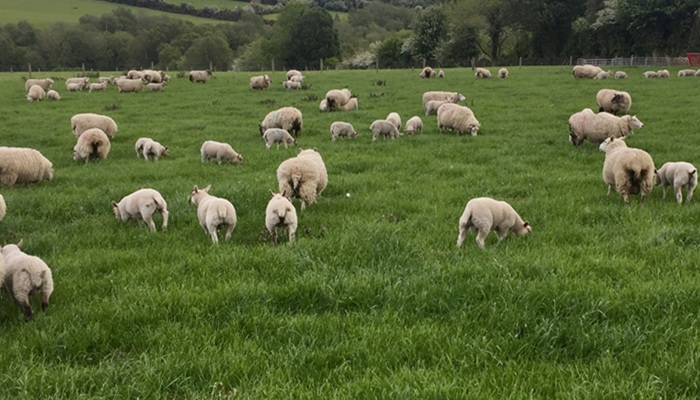22 April 2025
Nematodirus and coccidia in lambs

Nematodirus and coccidiosis can occur at the same time, so it is important to be aware of the risk from both types of parasites, Dr. Orla Keane of the Teagasc Animal & Bioscience Research Department tells us more.
Nematodirus
Nematodirus is an intestinal worm that causes disease in young lambs. It usually affects lambs between 6 and 12 weeks of age. It is a lamb crop to lamb crop disease i.e. the Nematodirus worm larvae that are picked up by this year’s lambs are from eggs that were deposited by last year’s lambs. This is because the lifecycle of Nematodius is a little different from that of the other intestinal worms that are found later in the grazing season.
The major difference is that Nematodirus eggs require a period of chilling followed by a period of warmer weather to hatch. Traditionally, the eggs shed by young lambs in spring are not chilled until the following winter; when the weather warms in spring, the eggs hatch.
However, as the climate becomes more unpredictable, hatching may occur at other times of the year. When the weather conditions are favourable, there is synchronised mass hatching of Nematodirus eggs, which are then available to infect naïve lambs.
When this hatch coincides with a time when lambs are beginning to consume significant amounts of grass, it can result in severe disease that can result in lamb deaths or cause damage to the gut that prevents the lambs from thriving in the future.
Rapid onset
Nematodirus can strike rapidly. Acute disease results in clinical signs that include sudden onset of scouring, dull and depressed lambs that may stop suckling, dehydration and weight loss. Lambs may gather around water troughs due to dehydration, while ewes will be unaffected and continue to graze.
It is important to prevent acute disease due to the long-term damage it can do. As Nematodirus is a lamb crop to lamb crop disease, grazing naïve lambs on pasture not grazed by lambs the previous season can prevent disease, although it may not be practical on many farms. Lambs consuming more grass, such as those being reared as twins or triplets or lambs from ewes with poor milking ability, will also be at increased risk, as will lambs under stress due to other diseases such as coccidia.
Predicting high-risk periods
Because the conditions for Nematodirus hatching are known, the high-risk periods for infection can be predicted. The Department of Agriculture, Food and the Marine in collaboration with Met Éireann produces a Nematodirus forecast each year that predicts when peak hatching will occur. This year the peak hatch is predicted to be at the end of March for much of the western coastal regions and early April in the Midlands, East and North West.
The Nematodirus forecast is available to view here.
Treatment options
Lambs should be treated approximately 2 weeks after the peak hatching. The recommended treatment is a benzimidazole anthelmintic – also known as a white wormer. While resistance to white wormers is common among intestinal worms found mid-season, white wormer resistance in Nematodirus is believed to be rare.
On some farms two treatments for Nematodirus may be needed, for example if lambs are treated too early or in mixed age groups where younger lambs may not be eating significant quantities of grass at the time of the initial treatment as no wormer has persistent activity against Nematodirus.
Faecal egg counts are of limited value as the larval stage of the parasite can cause significant damage before any eggs are produced. Therefore, treatment based on the Nematodirus forecast or signs of disease are recommended rather than relying on faecal egg counts.
Coccidia
Coccidia is also a parasitic disease of young lambs, usually from three weeks to 8-10 weeks of age. Signs include diarrhoea, dehydration and straining. In severe cases, the dung may contain blood and mucus and if left untreated can result in deaths.
This parasite is transmitted via the faecal-oral route. It is important to prevent coccidiosis and strict hygiene and keeping areas around drinkers and feeders clean and free from faecal matter helps reduce disease, including regularly moving outdoor feeders where necessary.
Faecal egg counts are also of limited value for coccidia as the parasite can cause damage before eggs appear. Additionally, there are many species of coccidia but only a few cause disease; however, it is not possible to distinguish the eggs of the different species. There are a number of veterinary medicines with efficacy against coccidia such as diclazuril and toltrazuril, which may be used to prevent disease.
Takeaway messages
Nematodirus and coccidiosis can occur at the same time, so it is important to be aware of the risk from both types of parasites. It can be difficult to distinguish between them as they have similar signs such as scouring. Risk factors, previous history and grazing history may give some indication of the risk from both types of parasites. Immunity to both Nematodirus and coccidia develops reasonably rapidly, meaning these parasites are rarely associated with disease in older animals.
For more information on flock health and dosing strategies, visit here.
